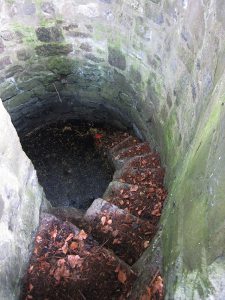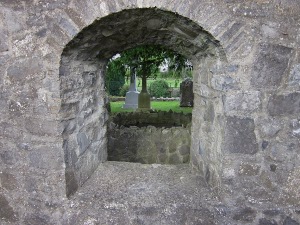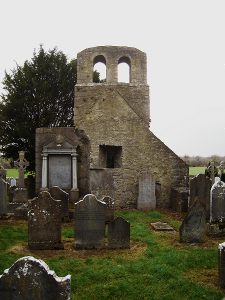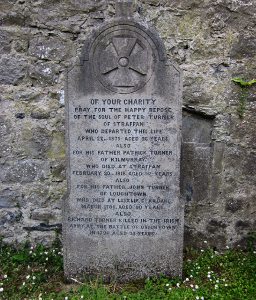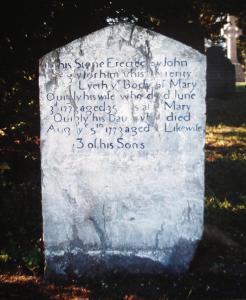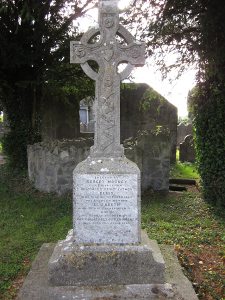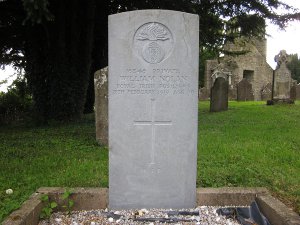A History of Ladychapel Graveyard
Published in two parts, part 1 in Maynooth Newsletter June 2013;
part 2 in Maynooth Newsletter July 2013
Ladychapel is a well known placename in north Kildare and is located almost halfway between Maynooth and Rathcoffey. The area is dominated by Ladychapel Church which is situated at a crossroads on the R406. It is an architectural gem dating from 1863, but it is named after an ancient ecclesiastical site situated three-quarters of a mile west of the crossroads at the end of a quant cul-dec-sac in the townland of Coanstown.1
Druidic Worship of Water-spring
This site has a history stretching back for at least 2000 years and consists of a disused burial ground which contains a stone lined Holy Well. It is acknowledged that Holy Wells predate the coming of Christianity to Ireland and originated as springs that were sacred sites associated with pre-Christian religious activity. The holy well at Ladychapel is a typical example of such a well and there are many pointers to suggest a pre-historic past.
Sligh Mór
Prior to the coming of Christianity Ladychapel was an important site on one of the principals roads in ancient Ireland. During this period five principal roads emerged in Ireland, all extending from Tara to various remote areas of the island. The principal road was named the Sligh Mór or ‘Great Road’. It extended from Tara to Dublin and then proceeded across the country to Galway Bay. The road passed alongside the ancient spring at Ladychapel. It is likely that the spring in addition to having an ecclesiastical significance it was also in use as a source of drinking water for travellers on the road.
Holy Well—Christian Meaning
With the coming of Christianity sites associated with the druidic religion were taken over by the Christians but many of the customs from this religion were retained and given a Christian meaning. Springs such as the one at Ladychapel were blessed by the early Christian missionaries and then became Holy Wells. An annual pattern which took the form of a religious festival emerged at the wells usually on the feast day of the patron saint of the locality or on the day that the pre-Christian festival was held. At Ladychapel it was likely that a pattern was held on ‘Lady Day’ 15th August, which is a day set aside on the Christian calendar for devotion to ‘Our Lady’.2 Sometimes cures attributed to the springs in the pre-Christian period survived into the Christian period when they became attributed to either the saint that the holy well was renamed after or other Christian saints. Traditionally, a visit to the holy well at Ladychapel cured those suffering from an ear-ache.
Prior to the establishment of parishes, ecclesiastical areas had emerged and Ladychapel was in a division that was centred on the monastery of Taghadoe. This area in the middle ages emerged as the parish of Taghadoe. The founder and patron saint of Taghadoe is St. Tua and it is not known what connection if any he had with Ladychapel.
Construction of Lady Chapel
Unfortunately, no documentary evidence on the construction of the old church in Ladychapel has come to light. Nearly all ancient Christian churches were oriented to the east; that is the gable end of the church with the altar facing the east. Ladychapel falls neatly into this category and significantly the east gable which is where the altar was situated is the closest section of the building to the holy well. The gable had a quaint window which overlooks the Holy Well.
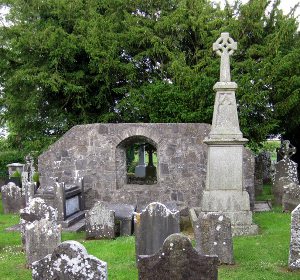
Lady Chapel east gable with the substantial Phepoe family monument on the right side and the tomb type memorial of Fr Ennis to the left
Much of the church ruins that survive may date from the late middle ages just prior to the reformation when a chapel was built. The first mention of the chapel comes from a document during the reign of James I, between 1603–1625 which indicated the existence of ‘a chapel of ease near Taghadoe, called Lady’s Chapel’.3 This building was never a parish church and was always regarded as a chapel of ease. All parish churches at the time of the reformation became Protestant churches. The local parish church in the area where Ladychapel is situated was at Taghadoe and it became the local Protestant church. Ladychapel was therefore never included in this category of churches. In the period subsequent to the late 17th century it became a ruin. However, due to the fact that it was consecrated ground, burials could take place within the chapel yard and as it wasn’t a churchyard of a parish church no burial fees were paid. Burial fees were collected at burials in the churchyards of parish churches, such as at Taghadoe, Balraheen and Laraghbryan and these would go to the Rector of the Parish. Ladychapel therefore became a popular burial ground for Catholics not only from the locality but was also popular with well-to-do individuals from further a field.
The Ordnance Survey letters from 1837 describes Ladychapel graveyard as follows:
There is a burial ground in the parish of Taghadoe called Coanstown burial ground, and containing the ruins of an old church. This ruin is called by the people Lady’s Chapel, within two perches of it there is a well called Lady’s well. Lady’s Day 15th August was formerly celebrated at this Chapel; but the frequency of people to it on this occasion, has ceased now some years back.4
Theory on the Placename
Unfortunately, the ancient place name or original name of the well has not survived. Ladychapel was not a name common to pre-Norman Ireland. Many theories have been put forward as to how Ladychapel obtained its placename. One suggestion is that it may be due to its connection with the 15th August which is traditionally known in Ireland as Lady Day and as a result the well became known as Lady Well. The name Ladychapel later emerged when the chapel was built close to the holy well.
Details of its pre-Christian past have not survived but due to the Marian connection the well may be connected to the festival of Lughnasa which was celebrated in ancient Ireland on the 1st August and throughout the early days of the month. This festival was the harvest celebration in honour of Lugh, the god of the harvest, who was responsible for the rewards of the harvest. With the coming of Christianity in many cases a Lughnasa connection gradually became associated with the feast of our Lady’s Assumption, which was celebrated on the 15th August. This Christian feast day was also referred to as ‘Lady-Day-in-Harvest’.5
Graveyards began to be enclosed by stone walls in the late 1700s and an act of Parliament provided for this in the early 1800. Many cemeteries would be encroached by animals and damage to graves would occur especially due to the presence of wandering cattle and pigs. A stone plaque on the cemetery wall at Ladychapel shows that is was enclosed in 1786 which would suggest it was one of the earliest cemeteries to be enclosed. Down through the years the graveyard has had its visits by grave robbers and many stories survive of local people guarding the cemetery after internments and chasing away the intruders.6
Thomas Swords
Many influential families from the general area among them some leading merchants and substantial tenant farmers acquired burial plots in graveyard throughout the 18th century. One of the wealthiest individuals interred in the burial ground is Thomas Swords whose memorial is one of the largest and impressive in the cemetery. He was a successful brewer from Crewhill and was associated with the Catholic Committee that petitioned for Catholic relief acts in the in the early 1790’s.
Connected to a Number of Events in Irish History
Today there are a substantial number of gravestones in the burial ground with many giving some interesting details of social background and family history. Some of the individuals interred in the burial ground are connected to many of the violent events in modern Irish History.
Rathcoffey Massacre Victims from 1642
Probably the most tragic deaths of individuals that rest in the burial ground are those who died as a result of a massacre in the 1640s. The wars of this period ravaged the country and resulted in huge losses of life. The massacre occurred in nearby Rathcoffey Castle when it was captured from rebels in 1642. All details of this atrocity were forgotten until the 1830s when workmen clearing woods close to Rathcoffey Castle uncovered human remains of the victims of this massacre.7 The local burial ground for most of the residents of Rathcoffey and surrounding townlands at the time was Ladychapel and the massacre victims were given a Christian burial in the graveyard. Unfortunately, as yet there is no memorial to those unfortunate victims in the burial ground.
1798 and Ovidstown
Ladychapel graveyard has a strong connection with the 1798 rebellion and at least two known fatalities of the rebellion are buried in the graveyard. One of the most historic hills in north Kildare is Ovidstown which can be seen clearly from Ladychapel. It was the site of a battle between United Irish Rebels and the regular British Army in June 1798 in which the rebels were defeated with a loss of 200 men. One of the rebel fatalities, Patrick Turner from nearby Loughtown was interred in the family burial plot in the graveyard. The monument over his grave is unique as it is one of the few gravestones that refers to an individual been a member of the ‘Irish Army in 1798’.
Another rebel who fought in the battle was William Norris from Kilcock. Following the battle he went into hiding but was captured and executed. He was buried in the grounds of the army barracks in Kilcock but his friends secretly exhumed his body and re-interred his remains in the family burial plot in Ladychapel. Another individual linked to the rebellion was Fr. Ennis the parish priest of Maynooth. A crown informer falsely linked him to having an involvement but the evidence was flawed. Fr Ennis died in 1821 and chose to be buried in Ladychapel.8
The burial ground also has a connection to the Robert Emmet conspiracy of 1803 with two key associates of Emmet, Michael Quigley and Mary Wilde interred in the burial ground. Michael Quigley from Rathcoffey was the head of Robert Emmet’s personal staff during the conspiracy and the woman later to be his wife Mary Wilde was an associate of both Emmet and Anne Devlin at the time of the rising. The last of their descendents Ellen Dunne from Johninstown who died in 1965 also rests in the graveyard.
Two other families with plots in the burial ground also have connections to this revolutionary period. Firstly, the Phoepoe family of Taghadoe House who are commemorated on one of the most substantial memorials in the graveyard. Fr. Nicholas Phoepoe a member of this family served as PP of Kilcullen in the 1790s and during the 1798 rebellion he arranged the safe surrender of local rebels to General Dundas.9 Secondly, Elizabeth Mooney from Smitstown House who was buried in the in the graveyard in 1872 also has strong family connections with this period. She was the daughter of John Kane a ‘98 rebel’ from Dublin who had associations with Lord Edward FitzGerald and Robert Emmet. Her mother Eleanor Troy was of the family of Archbishop John Thomas Troy who was a trustee of Maynooth College and during the revolutionary period served as Archbishop of Dublin.
First World War, Victim
Fatalities of the First World War are to be found interred in most cemeteries in Ireland. Ladychapel is no exception where there is a British military memorial to Private William Nolan. He was from Newtown, Maynooth and belonged to the Royal Irish Fusiliers regiment. He died almost three months after the ending of the war in February 1919 from the effects of gas suffered in the closing stages of the war.
Today Ladychapel graveyard is one of the most cared for cemeteries in north Kildare. Situated in a quiet pleasant and peaceful setting, few would imagine that this quaint resting place contains such a rich historical past with links to almost every period in Irish history.
- The construction costs was funded by John Dillon a Farm Steward from Carton who left a legacy in his will to cover the building of the Church.
- Lady Well at Mulhuddart has an annual pattern on 8th September.
- Ordnance Survey Letters, County Kildare, p. 11
- Ibid.
- See Lady-Day-in-Harvest published in Catholic Herald, 15th August 1941.
- See Myth and Memory, published by Maynooth Local History and Civic Forum (2002).
- Matthew Devitt, ‘Rathcoffey’ in the Journal of the Kildare Archaeological Society Volume III.
- For details, see Fugitive Warfare, (1998).
- Nicholas Phoepoe; probably his father was interred in the graveyard in 1775.

